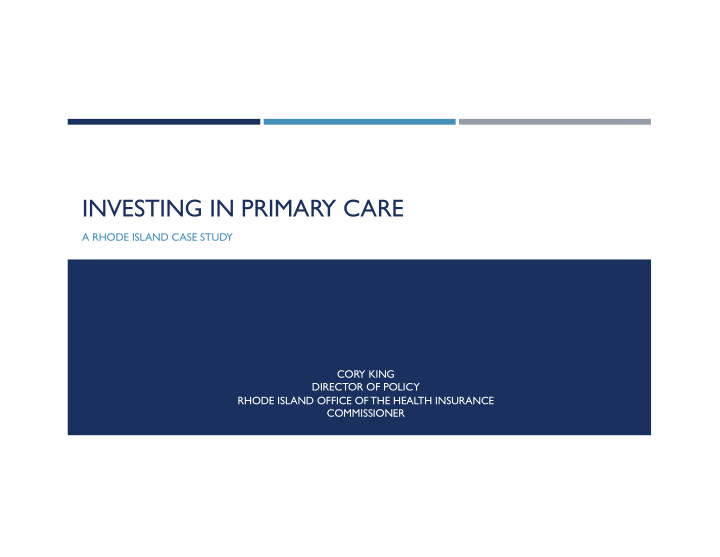



INVESTING IN PRIMARY CARE A RHODE ISLAND CASE STUDY CORY KING DIRECTOR OF POLICY RHODE ISLAND OFFICE OF THE HEALTH INSURANCE COMMISSIONER
ABOUT OHIC The Office of the Health Insurance Commissioner (OHIC) was created by the Rhode Island General Assembly in 2004. The agency is charged with protecting consumers, ensuring fair treatment of health care providers, guarding the solvency of insurers, and improving the health care system as a whole. RIGL 42-14.5-2 2
BACKGROUND ON THE AFFORDABILITY STANDARDS ¡ The Affordability Standards comprise a set of requirements for health insurers to follow in their efforts to improve the affordability of their products. ¡ The Affordability Standards are also designed to promote other aspects of OHIC’s mission, including consumer protection, access to care, and health care quality. 3
THE RATIONALE FOR PRIMARY CARE INVESTMENT Address underinvestment in Rhode Island compared to high performing health systems. Develop a policy lever to drive transformation of primary care and establish a foundation for broader system changes. Pursue an opportunity to improve system performance on cost, quality and access. 4
Measure your Define what baseline and compare constitutes spending to external on primary care. benchmarks. CONSIDERATIONS FOR POLICY DESIGN Confirm policy goals Articulate the with stakeholders and outcomes you want specify mechanisms to achieve. for investment. 5
THE AFFORDABILITY STANDARDS: FIRST WAVE (2010) MANDATED INCREASED PARTICIPATION IN FUNDING FOR PRICE CONTROLS, INVESTMENTS IN RHODE ISLAND’S MULTI- CURENTCARE, RHODE MANDATED SHIFT TO PRIMARY CARE PAYER PATIENT - ISLAND’S HEALTH DRGS, AND QUALITY THROUGH ANNUAL CENTERED MEDICAL INFORMATION INCENTIVE PROGRAMS INSURER SPENDING HOME PROGRAM. EXCHANGE . FOR HOSPITALS. TARGETS. 6
Primary Care Spending, Total and as Percent of Total Medical Spending 2008 - 2019 14.0% $90 Millions Primary Care Spending as Percent of Total Medical Total Primary Care $80 Primary Care % of Total Medical 12.0% 12.5% 12.3% $70 11.6% 11.5% 11.5% 10.0% $60 10.5% 9.8% 8.0% 9.1% $50 Spending 8.0% $40 6.0% 7.1% 6.3% $30 5.7% 4.0% $20 2.0% $10 0.0% $- 2008 2009 2010 2011 2012 2013 2014 2015 2016 2017 2018 2019 Forecast PRIMARY CARE INVESTMENT 7
Percent of Primary Care Spending Dedicated to Non-FFS Investments by Insurer 2008 - 2019 otal Primary Care Spending 84.0% 74.0% 64.0% 54.0% 44.0% 34.0% 24.0% Percent of T 14.0% 4.0% 2008 2009 2010 2011 2012 2013 2014 2015 2016 2017 2018 2019 Forecast BCB SRI 8.8% 13.5% 23.6% 29.0% 39.6% 40.1% 46.7% 53.2% 51.3% 56.3% 57.8% 57.2% UHC 2.0% 5.9% 13.9% 23.8% 33.0% 42.0% 54.6% 56.4% 51.2% 50.0% 59.0% 54.4% THP 6.0% 12.2% 12.5% 12.2% 17.0% 25.5% 33.6% 41.3% 69.0% 69.5% 75.0% NHP 0.1% 11.0% 9.6% 17.7% 14.2% EMPHASIS ON NON-FFS INVESTMENTS 8
BENDING THE COST CURVE Source: Baum, A., Song, Z., Landon, B., Phillips, R., Bitton, A., Basu, S. (2019). Health Care Spending Slowed After Rhode Island Applied Affordability Standards to Commercial Insurers. Health Affairs, 38(2) , 237-245. https://doi.org/10.1377/hlthaff.2018.05164 9
WHERE DOES PRIMARY CARE INVESTMENT GET US? Investment standards have promoted multi-payer collaboration on practice transformation and a focus on cost and quality. The number of PCMHs increased from 0 in 2008 to 186 in 2020 and about 65% of primary care clinicians are practicing in a PCMH. Primary care investment lays the foundation for more systemic innovations (ACOs, risk-based contracting). 10
PAYMENT REFORM UNDER THE AFFORDABILITY STANDARDS DOLLARS PAID UNDER APMS AND APM DOLLARS AS PERCENT OF TOTAL MEDICAL SPENDING 2014 - 2017 50.0% $600 Millions 45.0% $500 40.0% 35.0% $400 30.0% 25.0% $300 20.0% $200 15.0% 10.0% $100 5.0% 0.0% $- 2014A 2015A 2016A 2017A Total Dollars Paid Under APMs APM Percent 11
TRANSITION TO RISK-BASED CONTRACTS DISTRIBUTION OF POPULATION-BASED CONTRACT CLAIMS PAYMENTS IN UPSIDE-ONLY VS DOWNSIDE RISK MODELS $450 Millions $404 $400 $350 $305 $300 $219 $250 $204 $200 $150 $137 $100 $62 $50 $3 $6 $- 2014A 2015A 2016A 2017A Upside Gainsharing Only Downside Risk Note: Payments include allowed claims for all members attributed to providers under population-based contracts and which are subject to the contractual 12 budget target.
Understand your goals and the logic of change. Include primary care as part of a broader strategy. LESSONS Don’t overpromise on results. LEARNED Maintain an openness to course correction. Primary care needs a champion in government. 13
Recommend
More recommend